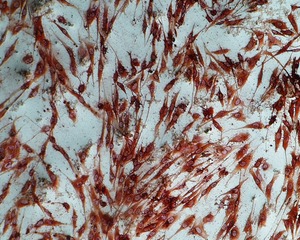Bovine viral diarrhea
Viral disease affecting cattle

Bovine viral diarrhea (BVD) is a significant infectious disease affecting cattle worldwide. It is caused by the Bovine viral diarrhea virus (BVDV), which belongs to the genus Pestivirus in the family Flaviviridae. BVD can lead to a range of clinical manifestations, from subclinical infections to severe disease, impacting the health and productivity of cattle.
Virology[edit]

BVDV is an RNA virus with a single-stranded, positive-sense RNA genome. The virus is classified into two main genotypes, BVDV-1 and BVDV-2, each with multiple subtypes. These genotypes can further be divided into cytopathic (cp) and non-cytopathic (ncp) biotypes based on their effects on cultured cells. The ncp biotype is more commonly associated with persistent infections in cattle.
Transmission[edit]
BVDV is primarily transmitted through direct contact with infected animals. The virus can be spread via bodily secretions such as saliva, nasal discharge, urine, and feces. Vertical transmission from dam to fetus can occur, leading to persistently infected (PI) calves if the infection occurs during early pregnancy.
Clinical Signs[edit]
The clinical presentation of BVD can vary widely. In acute infections, cattle may exhibit fever, diarrhea, respiratory distress, and immunosuppression. In pregnant cows, BVDV can cause reproductive issues such as abortion, stillbirth, or the birth of weak calves. PI animals often appear normal but can develop mucosal disease, characterized by severe ulceration of the gastrointestinal tract and high mortality.
Diagnosis[edit]
Diagnosis of BVD involves a combination of clinical observation, serological testing, and molecular techniques. Polymerase chain reaction (PCR) and enzyme-linked immunosorbent assay (ELISA) are commonly used to detect viral RNA and antibodies, respectively. Identifying PI animals is crucial for controlling the spread of the virus.
Prevention and Control[edit]

Effective control of BVD involves a combination of biosecurity measures, vaccination, and management practices. Vaccination programs can help reduce the incidence of acute infections and prevent fetal infections. Biosecurity measures include testing and culling PI animals, controlling animal movement, and maintaining closed herds.
Economic Impact[edit]
BVD has a significant economic impact on the cattle industry due to decreased productivity, increased veterinary costs, and losses from reproductive failures. The presence of PI animals in a herd can lead to ongoing transmission and outbreaks, further exacerbating economic losses.
Related Pages[edit]
Ad. Transform your life with W8MD's Budget GLP-1 injections from $75


W8MD offers a medical weight loss program to lose weight in Philadelphia. Our physician-supervised medical weight loss provides:
- Weight loss injections in NYC (generic and brand names):
- Zepbound / Mounjaro, Wegovy / Ozempic, Saxenda
- Most insurances accepted or discounted self-pay rates. We will obtain insurance prior authorizations if needed.
- Generic GLP1 weight loss injections from $75 for the starting dose.
- Also offer prescription weight loss medications including Phentermine, Qsymia, Diethylpropion, Contrave etc.
NYC weight loss doctor appointmentsNYC weight loss doctor appointments
Start your NYC weight loss journey today at our NYC medical weight loss and Philadelphia medical weight loss clinics.
- Call 718-946-5500 to lose weight in NYC or for medical weight loss in Philadelphia 215-676-2334.
- Tags:NYC medical weight loss, Philadelphia lose weight Zepbound NYC, Budget GLP1 weight loss injections, Wegovy Philadelphia, Wegovy NYC, Philadelphia medical weight loss, Brookly weight loss and Wegovy NYC
|
WikiMD's Wellness Encyclopedia |
| Let Food Be Thy Medicine Medicine Thy Food - Hippocrates |
Medical Disclaimer: WikiMD is not a substitute for professional medical advice. The information on WikiMD is provided as an information resource only, may be incorrect, outdated or misleading, and is not to be used or relied on for any diagnostic or treatment purposes. Please consult your health care provider before making any healthcare decisions or for guidance about a specific medical condition. WikiMD expressly disclaims responsibility, and shall have no liability, for any damages, loss, injury, or liability whatsoever suffered as a result of your reliance on the information contained in this site. By visiting this site you agree to the foregoing terms and conditions, which may from time to time be changed or supplemented by WikiMD. If you do not agree to the foregoing terms and conditions, you should not enter or use this site. See full disclaimer.
Credits:Most images are courtesy of Wikimedia commons, and templates, categories Wikipedia, licensed under CC BY SA or similar.
Translate this page: - East Asian
中文,
日本,
한국어,
South Asian
हिन्दी,
தமிழ்,
తెలుగు,
Urdu,
ಕನ್ನಡ,
Southeast Asian
Indonesian,
Vietnamese,
Thai,
မြန်မာဘာသာ,
বাংলা
European
español,
Deutsch,
français,
Greek,
português do Brasil,
polski,
română,
русский,
Nederlands,
norsk,
svenska,
suomi,
Italian
Middle Eastern & African
عربى,
Turkish,
Persian,
Hebrew,
Afrikaans,
isiZulu,
Kiswahili,
Other
Bulgarian,
Hungarian,
Czech,
Swedish,
മലയാളം,
मराठी,
ਪੰਜਾਬੀ,
ગુજરાતી,
Portuguese,
Ukrainian